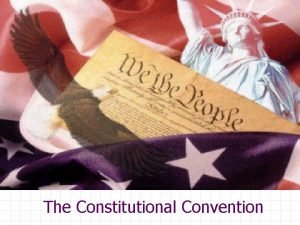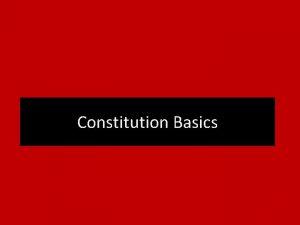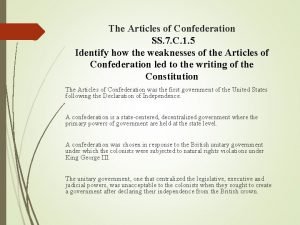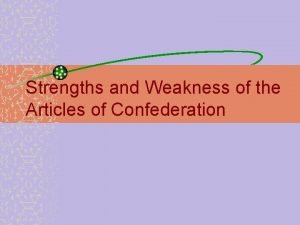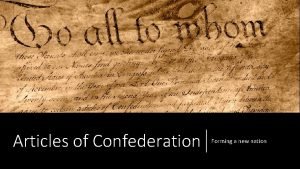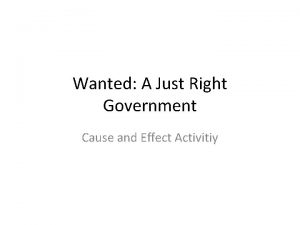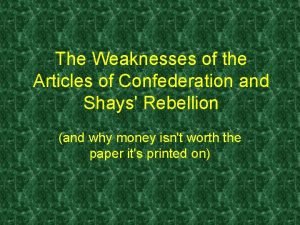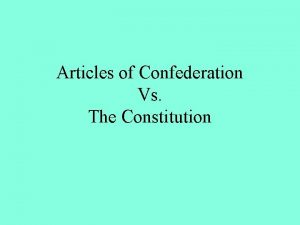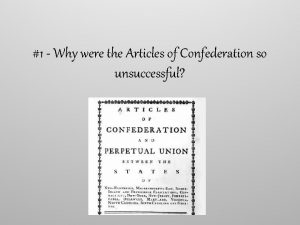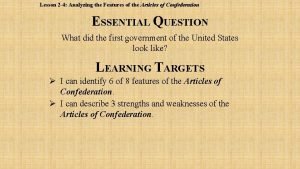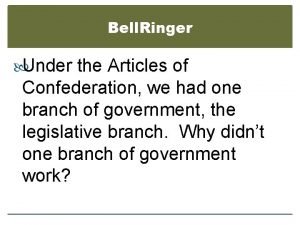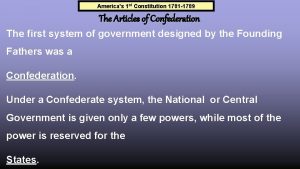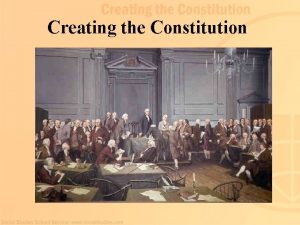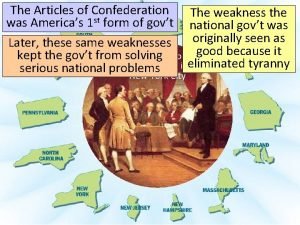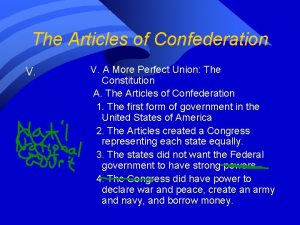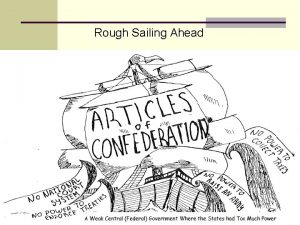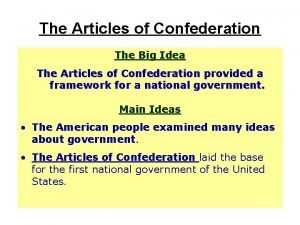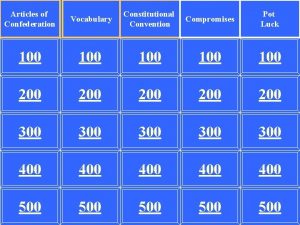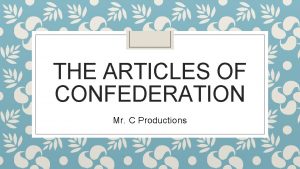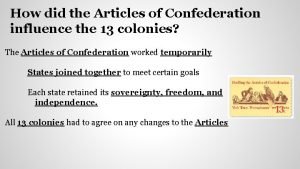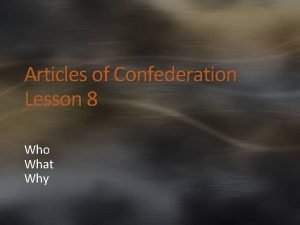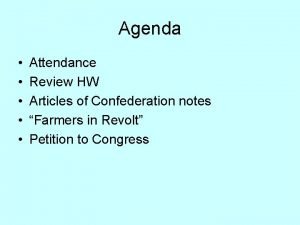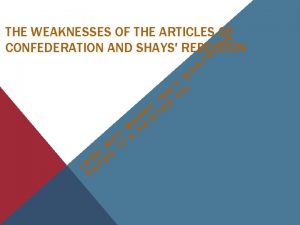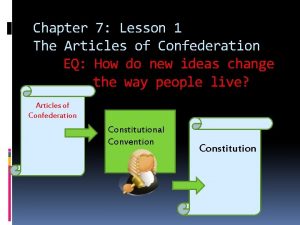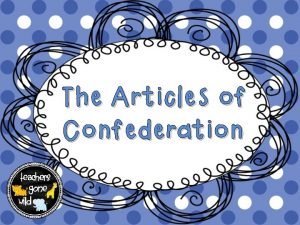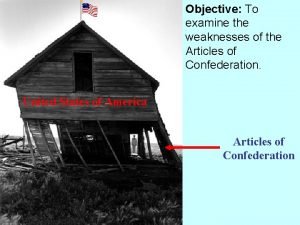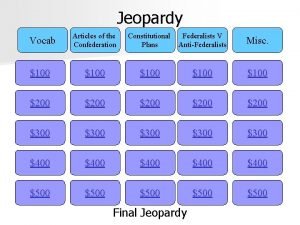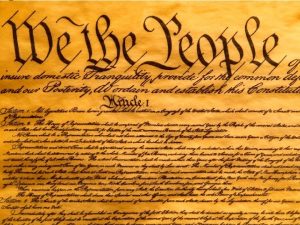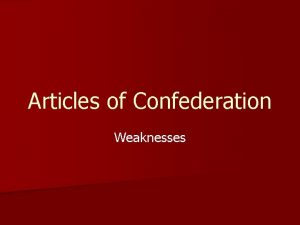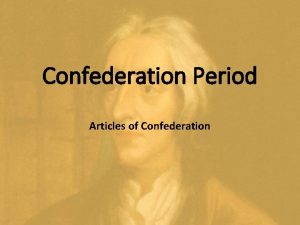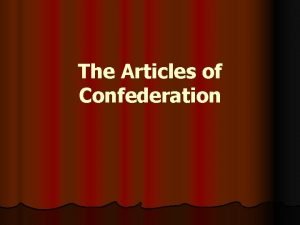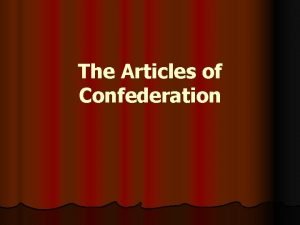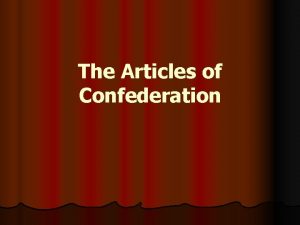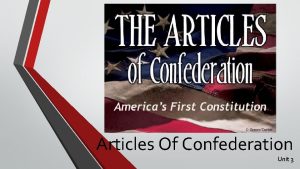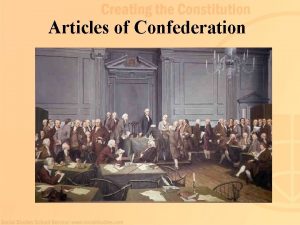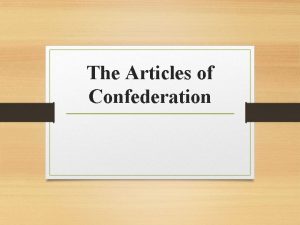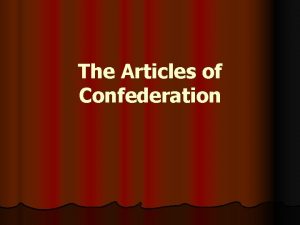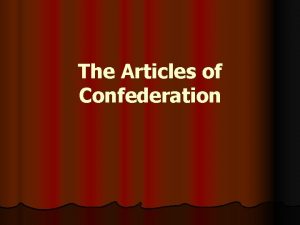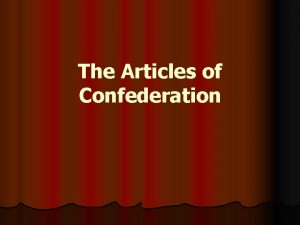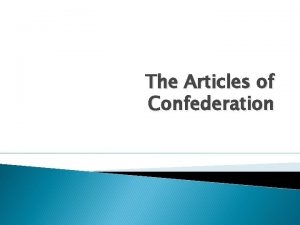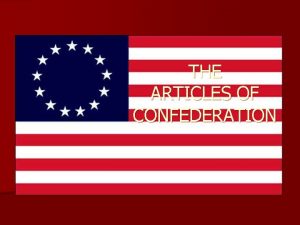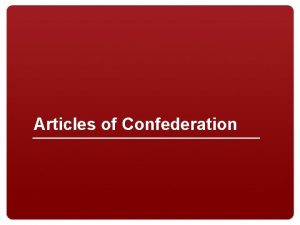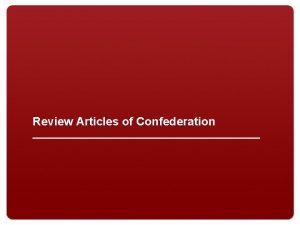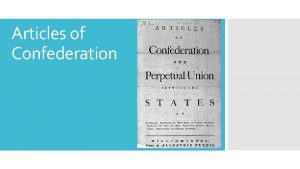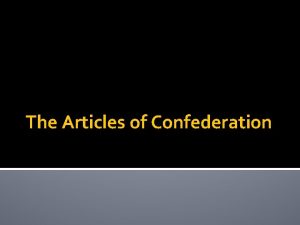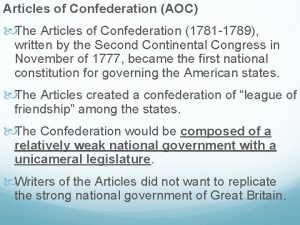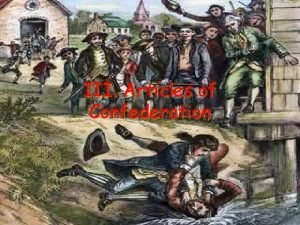Articles of Confederation 1 Weaknesses of the Articles





























- Slides: 29

Articles of Confederation 1. Weaknesses of the Articles 2. Why did they make the Articles gov’t weak on purpose? 3. Why didn’t the founders include an executive branch? 4. How was the Northwest Territory land important to approving the Articles gov’t 5. How did the Philadelphia riots expose problems with the Articles gov’t 6. How did the Shays Rebellion expose problems with the Articles gov’t 7. Why would states raise taxes on their citizens during this time period (I mean, they’d just gotten mad at Parliament FOR taxes!)

Constitutional Convention 1. Who was at the Constitutional Convention? 2. Where was the Constitution written? 3. What did delegates agree upon early in the Convention? 4. Why is James Madison called the “Father of the Constitution”? 5. Why was secrecy important to the members of the Constitutional Convention?

Constitutional Convention 6. Explain the elements of the Virginia Plan, and be able to compare them to the elements of the New Jersey Plan 7. Who liked the Virginia Plan and why did they like it? 8. Who liked the New Jersey Plan and why did they like it? 9. How did the founders solve the “representation” issue for Congress? 10. What would have happened if the Great Compromise never occurred? 11. Why did the Convention need to determine how much a slave was “worth”?

How the Government Works 1. What are three branches of government? 2. What are the main jobs of the 3 branches? (chart on next page) 3. How is the Constitutional gov’t Congress stronger than the Articles’ Congress? 4. Describe the differences between the Senate and the House of Representatives 5. What are the terms of office for each branch? (chart on next page) 6. What are the qualifications for members of each branch? (chart on next page) 7. What does “checks and balances” or “balance of power” have to do with our 3 branches of government? 8. Why were some people opposed to ratifying the Constitution? What were they called? 9. How does the Constitution improves upon the Articles of Confederation government?

Executive Main Job Term of Office Qualifications Legislative Judicial

KEY Ratify ing, h t e som tion e v itu pro t p s a n To Co Our l Vocabulary he like t Congress aw-m aking of 2 c body, m ham bers ade up Federal al n o i t r na nt o f d or me w n r r e e v h Anot entral go or c To ch ange Amend some docu thing, li ke a men t Commerce Another word for business Sovereign old h o t rol; r t n o in c l powe e b To ica polit

Vocabulary Ratify Federal Commerce Another word Our l ld o e for h h aw-lm T t al o o n t e c k ; o i i h l t a o a business kring nge s hing, ntr r na nt o o c b f t e o o e n d m oofw dy m ethnin or ei me w n r r o e i To b olitical p 2 chamb , madperouvedsoocuim e g t v erso ap p onst tuent , like a noth ntral go p A T C or ce Congress Amend Sovereign

Vocabulary Congress Commerce Amend Another word Our l ld o e for h h aw-lm T t al o o n t e c k ; o i i h l t a o a business kring nge s hing, ntr r na nt o o c b f t e o o e n d m oofw dy m ethnin or ei me w n r r o e i To b olitical p 2 chamb , madperouvedsoocuim e g t v erso ap p onst tuent , like a noth ntral go p A T C or ce Ratify Sovereign Federal

Ratify Vocabulary Congress Federal Amend Sovereign Commerce Our l ld o h a w o taor Anothroe-rlm ; w e krindgfor t h To ch t n al o n e c b k o e i i o l t n o w ange i d , a b f 2 escs hamrd fyo, rmnadeent smoemtheing To be liticalupsoin o bers rnm up o tohning soo p w r e d i e v t , like csutim tuen oth tral gove pro n p a a A n t n To Co or ce

States are sovereign. KEY No federal courts -all laws enforced by state courts Sovereignty is divided between the sates and the federal government. Separate judicial branch for the federal courts system No separate executive branch. No president. Separate executive branch, chosen by an electoral college Congress has NO power to regulate commerce with other nations or among states. Congress has NO taxing power. Congress consists of 1 chamber. Each state has 1 vote. State governments have much more power than the federal government. Can be amended with approval of all states Congress is allowed to regulate commerce with other nations and among the states. Congress has the power to tax. Congress consists of 2 bodies, the House of Representatives and the Senate. House of Reps. =# of representatives is based on state’s population Both federal government and state governments have powers (although central government has more than the states) Constitution can be amended with approval of ¾ of the states.

Sovereignty is divided between the sates and the federal government. States are sovereign. Separate judicial branch for the federal courts system No federal courts -all laws enforced by state courts No separate executive branch. No president. Separate executive branch, chosen by an electoral college Congress has NO power to regulate commerce with other nations or among states. Congress is allowed to regulate commerce with other nations and among the states. Congress has the power to tax. Congress has NO taxing power. Congress consists of 2 bodies, the House of Representatives and the Senate. House of Reps. =# of representatives is based on state’s population Congress consists of 1 chamber. Each state has 1 vote. Both federal government and state governments have powers (although central government has more than the states) State governments have much more power than the federal government. Constitution can be amended with approval of ¾ of the states. Can be amended with approval of all states

Sovereignty is divided between the sates and the federal government. States are sovereign. Separate judicial branch for the federal courts system No federal courts -all laws enforced by state courts No separate executive branch. No president. Separate executive branch, chosen by an electoral college Congress has NO power to regulate commerce with other nations or among states. Congress is allowed to regulate commerce with other nations and among the states. Congress has the power to tax. Congress has NO taxing power. Congress consists of 2 bodies, the House of Representatives and the Senate. House of Reps. =# of representatives is based on state’s population Congress consists of 1 chamber. Each state has 1 vote. Both federal government and state governments have powers (although central government has more than the states) State governments have much more power than the federal government. Constitution can be amended with approval of ¾ of the states. Can be amended with approval of all states

Sovereignty is divided between the sates and the federal government. States are sovereign. Separate judicial branch for the federal courts system No federal courts -all laws enforced by state courts No separate executive branch. No president. Separate executive branch, chosen by an electoral college Congress has NO power to regulate commerce with other nations or among states. Congress is allowed to regulate commerce with other nations and among the states. Congress has the power to tax. Congress has NO taxing power. Congress consists of 2 bodies, the House of Representatives and the Senate. House of Reps. =# of representatives is based on state’s population Congress consists of 1 chamber. Each state has 1 vote. Both federal government and state governments have powers (although central government has more than the states) State governments have much more power than the federal government. Constitution can be amended with approval of ¾ of the states. Can be amended with approval of all states

KEY President Congress Justices

KEY ENFORCE LAWS PRESIDENT COMMANDER-IN-CHIEF PASS/VETO LAWS CONGRESS SENATE MAKE LAWS SENATOR HOUSE OF REPRESENTATIVES SUPREME COURT 100 REPRESENTATIVE 9 JUSTICE COURTS 435 INTERPRET LAWS JUDGES FINAL SAY

KEY 35 years old 4 year terms President White House Congress 30 years old 25 years old Native born citizen $400, 000 Capitol 6 year terms 2 year terms No limit Justices Supreme Court Citizen for 9 years Citizen for 7 years $175, 000 $140, 000

KEY PRESIDENT/ COMMANDER-IN-CHIEF CABINET CONGRESS ENFORCES LAWS REGULATE TRADE COLLECT TAXES APPOINTS SUPREME COURT JUDGES, FEDERAL JUDGES & CABINET MEMBERS INTERPRETS LAWS CREATES LAWS GRANTS PARDONS TO CRIMINALS CAN DECLARE LAWS UNCONSTITUTIONAL SELECTED BY ELECTORAL COLLEGE NEGOTIATES TREATIES APPROVES PRESIDENTAL APPOINTMENTS PRINTS MONEY SELECTED BY POPULAR VOTE SUPREME COURT REPRESENTS USA DECLARES WAR

White House Supreme Court Capitol $140, 000 25 years old 35 years old No limit 30 years old $175, 000 $400, 000 Citizen for 9 years Citizen for 7 years Native born citizen Justices 4 year terms Congress 6 year terms 2 year terms No limit President

$400, 000 $175, 000 25 years old 35 years old $140, 000 No limit 30 years old Citizen for 9 years Citizen for 7 Native born years citizen No limit President 6 year terms 4 year terms 2 year terms Supreme Court Capitol White House Justices Congress

$140, 000 $400, 000 $175, 000 30 years old No limit 25 years old Congress Justices 35 years old Citizen for 9 Citizen for 7 years Native born citizen President 6 year terms No limit 4 year terms 2 year terms Capitol White House Supreme Court

President Justices Congress

Justices President Congress

Congress Justices President

100 PASS/VETO LAWS JUSTICE SENATOR SUPREME COURT MAKE LAWS JUDGES FINAL SAY ENFORCE LAWS CONGRESS COURTS SENATE 435 REPRESENTATIVE 9 HOUSE OF REPRESENTATIVES PRESIDENT COMMANDER-IN-CHIEF INTERPRET LAWS

COURTS CONGRESS 9 INTERPRET LAWS COMMANDER-IN-CHIEF MAKE LAWS ENFORCE LAWS 435 100 SENATE SENATOR PASS/VETO LAWS FINAL SAY JUDGES REPRESENTATIVE HOUSE OF REPRESENTATIVES JUSTICE SUPREME COURT PRESIDENT

ENFORCE LAWS SENATOR COMMANDER-IN-CHIEF INTERPRET LAWS CONGRESS MAKE LAWS FINAL SAY REPRESENTATIVE JUSTICE COURTS PASS/VETO LAWS JUDGES 435 PRESIDENT HOUSE OF REPRESENTATIVES SENATE 9 SUPREME COURT 100

PRESIDENT/ COMMANDER-IN-CHIEF CABINET CONGRESS ENFORCES LAWS REGULATE TRADE COLLECT TAXES APPOINTS SUPREME COURT JUDGES, FEDERAL JUDGES & CABINET MEMBERS INTERPRETS LAWS CREATES LAWS GRANTS PARDONS TO CRIMINALS CAN DECLARE LAWS UNCONSTITUTIONAL SELECTED BY ELECTORAL COLLEGE NEGOTIATES TREATIES APPROVES PRESIDENTAL APPOINTMENTS PRINTS MONEY SELECTED BY POPULAR VOTE SUPREME COURT REPRESENTS USA DECLARES WAR

PRESIDENT/ COMMANDER-IN-CHIEF CABINET CONGRESS REPRESENTS USA DECLARES WAR INTERPRETS LAWS CAN DECLARE LAWS UNCONSTITUTIONAL COLLECT TAXES APPOINTS SUPREME COURT JUDGES, FEDERAL JUDGES & CABINET MEMBERS GRANTS PARDONS TO CRIMINALS SELECTED BY POPULAR VOTE SELECTED BY ELECTORAL COLLEGE APPROVES PRESIDENTAL APPOINTMENTS ENFORCES LAWS PRINTS MONEY CREATES LAWS SUPREME COURT REGULATE TRADE NEGOTIATES TREATIES

PRESIDENT/ COMMANDER-IN-CHIEF CABINET CONGRESS ENFORCES LAWS REGULATE TRADE COLLECT TAXES DECLARES WAR CREATES LAWS GRANTS PARDONS SELECTED BY POPULAR VOTE TO CRIMINALS SELECTED BY ELECTORAL COLLEGE APPROVES PRESIDENTAL APPOINTMENTS CAN DECLARE LAWS UNCONSTITUTIONAL INTERPRETS LAWS SUPREME COURT NEGOTIATES TREATIES PRINTS MONEY APPOINTS SUPREME COURT JUDGES, FEDERAL JUDGES REPRESENTS USA & CABINET MEMBERS
 When was the great compromise
When was the great compromise Weaknesses of articles of confederation
Weaknesses of articles of confederation Articles of confederation weaknesses
Articles of confederation weaknesses Characteristics of the articles of confederation
Characteristics of the articles of confederation Political weaknesses of the articles of confederation
Political weaknesses of the articles of confederation Strengths of the articles of confederation
Strengths of the articles of confederation Articles of confederation
Articles of confederation Wanted a just right government cause and effect answer key
Wanted a just right government cause and effect answer key Articles of confederation strengths
Articles of confederation strengths Constitution vs articles of confederation
Constitution vs articles of confederation Why were the articles of confederation unsuccessful
Why were the articles of confederation unsuccessful Strengths of the articles of confederation
Strengths of the articles of confederation Articles of confederation bell ringer
Articles of confederation bell ringer Achievements of the articles of confederation
Achievements of the articles of confederation Problems with the articles of confederation
Problems with the articles of confederation Articles of confederation
Articles of confederation Articles of confederation strengths
Articles of confederation strengths Rough sailing ahead political cartoon source
Rough sailing ahead political cartoon source 3 5ths compromise
3 5ths compromise Articles of confederation vocabulary
Articles of confederation vocabulary Articles of confederation
Articles of confederation How did the articles of confederation fail
How did the articles of confederation fail Lesson 8 the articles of confederation
Lesson 8 the articles of confederation Articles of confederation fail
Articles of confederation fail Achievements of the articles of confederation
Achievements of the articles of confederation Chapter 7 lesson 1 answer key
Chapter 7 lesson 1 answer key Shays rebellion clipart
Shays rebellion clipart Articles of confederation fail
Articles of confederation fail Articles of confederation jeopardy
Articles of confederation jeopardy The articles of confederation main idea
The articles of confederation main idea
